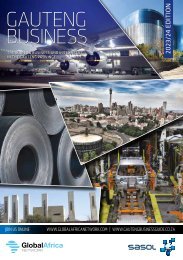Service - Leadership in Government - Issue 75
You also want an ePaper? Increase the reach of your titles
YUMPU automatically turns print PDFs into web optimized ePapers that Google loves.
S<br />
service report<br />
2020 Global Cities Report<br />
creat<strong>in</strong>g a dialogue on a specific topic, and exchang<strong>in</strong>g<br />
<strong>in</strong>sights and practices related to common challenges. As<br />
cities become smarter and more digitally enabled, they<br />
will be even better equipped to f<strong>in</strong>d global solutions that<br />
can be applied <strong>in</strong> their own areas. Elsewhere, global<br />
advocacy networks amplify important city-level issues<br />
that can only be solved with broader <strong>in</strong>put, for example<br />
where city leaders lack the political authority to make<br />
necessary decisions. The ICLEI (Local <strong>Government</strong>s<br />
for Susta<strong>in</strong>ability) is one such city network. It and other<br />
networks like it have access to decision-makers at a range<br />
of <strong>in</strong>ternational authorities and organisations such as the<br />
United Nations, giv<strong>in</strong>g cities a voice they would otherwise<br />
lack at a global level. This enables city leaders to help<br />
garner global-level resources for challenges of a global<br />
scale that are experienced at a local level.<br />
Forg<strong>in</strong>g <strong>in</strong>ternational economic partnerships.<br />
Complementary economic partnerships between<br />
cities also deliver mutual advantages that augment<br />
traditional ways of generat<strong>in</strong>g economic value. Rather<br />
than traditional sister city relationships, which tend<br />
to be bound by political or cultural ties, partnerships<br />
based on economic well-be<strong>in</strong>g can help cities develop<br />
new specialisations, spark market opportunities, attract<br />
foreign <strong>in</strong>vestment, support <strong>in</strong>dustry collaboration, and<br />
become more visible on the world stage, even where<br />
national flows are falter<strong>in</strong>g around them. Arrangements<br />
such as these open up partner cities as gateways for<br />
foreign <strong>in</strong>vestment, support<strong>in</strong>g key local <strong>in</strong>dustries and<br />
workers, and boost their stand<strong>in</strong>g <strong>in</strong> global markets and<br />
<strong>in</strong>dustry value cha<strong>in</strong>s.<br />
Guid<strong>in</strong>g the transformation of urban space. As we<br />
have seen, the latest pandemic has triggered widespread<br />
changes <strong>in</strong> behaviour and accelerated several preexist<strong>in</strong>g<br />
urban trends. People are spend<strong>in</strong>g more time<br />
onl<strong>in</strong>e than ever, and remote work<strong>in</strong>g looks set to stay.<br />
The untether<strong>in</strong>g of work from the office has led some to<br />
worry about the suburban sprawl that city planners have<br />
spent so long combatt<strong>in</strong>g.<br />
The Covid experience has also highlighted some of<br />
the deep-rooted <strong>in</strong>equalities <strong>in</strong> urban centres, po<strong>in</strong>t<strong>in</strong>g<br />
Mar<strong>in</strong>a Bay, S<strong>in</strong>gapore<br />
to how they must change. Overwhelm<strong>in</strong>gly, the people<br />
carry<strong>in</strong>g out “essential services”, who are at greater risk<br />
from the virus, are of low-<strong>in</strong>come and m<strong>in</strong>ority groups.<br />
They also live <strong>in</strong> more cramped conditions than wealthier<br />
residents, and are more likely to suffer from chronic<br />
health conditions related to lack of access to clean water<br />
or poor air quality.<br />
REBUILD TRUST IN PUBLIC TRANSIT<br />
While rebalanc<strong>in</strong>g population density is a long-term effort, cities need<br />
economic relief now, and that means gett<strong>in</strong>g residents mov<strong>in</strong>g more freely<br />
aga<strong>in</strong>. To do that, they will have to rebuild trust <strong>in</strong> public transport, and<br />
give people the confidence it is safe to use. Many cities have already<br />
taken action: <strong>in</strong> Paris, artificial <strong>in</strong>telligence has been deployed to measure<br />
compliance with the requirement to wear masks, and employers <strong>in</strong> New<br />
York City have been asked to allow flexible start times to reduce travel<br />
dur<strong>in</strong>g peak hours.<br />
The next frontier will be real-time mapp<strong>in</strong>g platforms with comprehensive<br />
travel <strong>in</strong>formation, to help citizens m<strong>in</strong>imise wait times and avoid crowds,<br />
and give providers and authorities the <strong>in</strong>formation they need to make<br />
transit systems even more flexible and resilient over time. The Transit app<br />
aims to do just this, and is already available <strong>in</strong> 200 cities, where those with<br />
contactless payment systems provide valuable data to feed the system.<br />
With the fabric of cities hav<strong>in</strong>g unravelled so decidedly<br />
dur<strong>in</strong>g the crisis, and unlikely to resume its former<br />
shape, leaders now have a compell<strong>in</strong>g reason and unique<br />
opportunity to transform the urban environment <strong>in</strong>to<br />
someth<strong>in</strong>g more susta<strong>in</strong>able, more resilient and more<br />
equal. With strategic <strong>in</strong>vestment of capital and political<br />
will <strong>in</strong> key areas, progress could be accelerated <strong>in</strong> a way<br />
that has not been seen before, by b<strong>in</strong>d<strong>in</strong>g urban plann<strong>in</strong>g<br />
more closely with economic and social needs, and longterm<br />
trends such as climate change. However, city leaders<br />
must act quickly as the w<strong>in</strong>dow of opportunity is narrow.<br />
WHERE TO NEXT?<br />
For global cities, the current crisis and emerg<strong>in</strong>g<br />
future demand significant adaptive change. Some of<br />
the fundamental factors that have historically enabled<br />
them to create value have been pa<strong>in</strong>fully disrupted,<br />
many of the connections between them are teeter<strong>in</strong>g<br />
on a knife’s edge, and the ways <strong>in</strong> which they use and<br />
allocate space require an urgent reth<strong>in</strong>k. However, not<br />
only do the tools for tackl<strong>in</strong>g this new environment exist,<br />
but the pandemic and its aftermath have also created a<br />
rare openness to do<strong>in</strong>g th<strong>in</strong>gs differently. Seiz<strong>in</strong>g this<br />
opportunity won’t be easy, or a short-term affair. But if<br />
we can be certa<strong>in</strong> of anyth<strong>in</strong>g, it’s that cities will adapt<br />
and evolve, and that they have the potential to come<br />
back stronger. The proposals outl<strong>in</strong>ed <strong>in</strong> this report are<br />
<strong>in</strong>tended to help city leaders take the concrete, practical<br />
action needed to create what is next for their cities and<br />
def<strong>in</strong>e what a global city now looks like. S<br />
30 | <strong>Service</strong> magaz<strong>in</strong>e


















